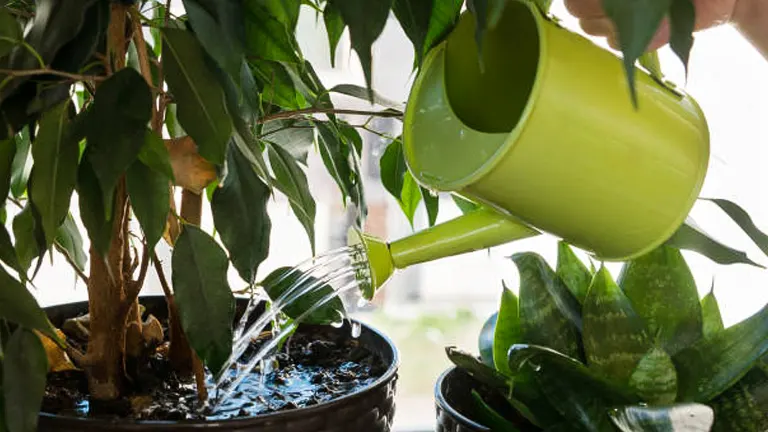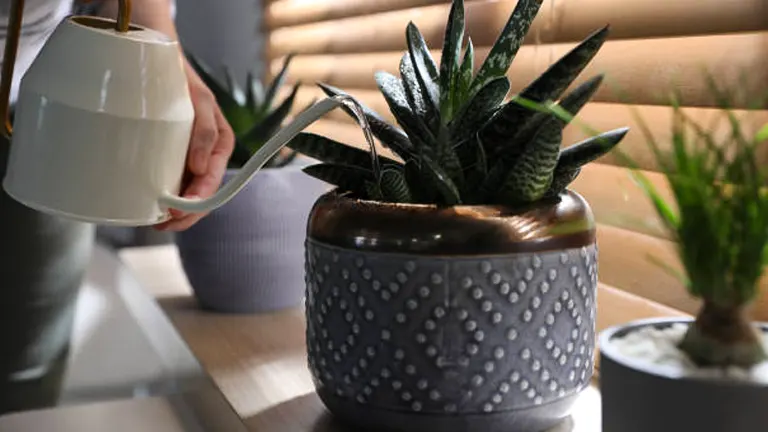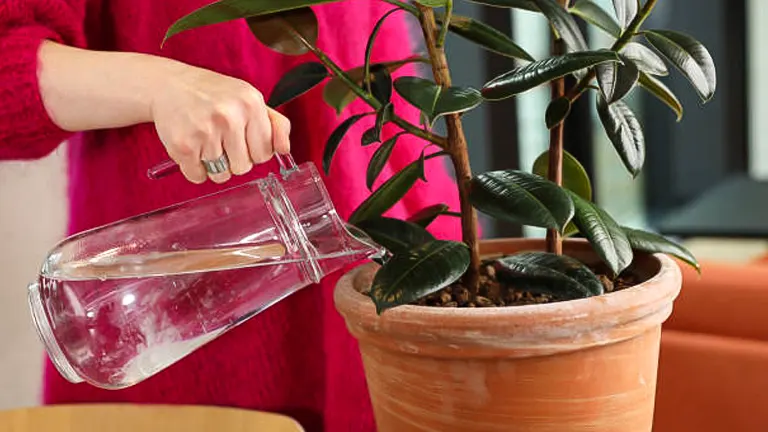How to Water Indoor Plants for Optimal Health: Proven Strategies
- June 11, 2024
- 0 comment
Learn how to water indoor plants for optimal health with this guide. Master proven strategies for lush growth and vibrant foliage. Ready to elevate your indoor gardening skills to new heights? Navigating the nuances of watering indoor plants can be the difference between thriving greenery and disappointing droops.

In this detailed guide, we’ll unveil expert strategies to ensure your houseplants not only survive but flourish spectacularly. Join us as we transform watering from a routine chore into a flourishing art form!
Table of Contents
- Understanding Plant Watering Needs
- Proven Watering Strategies
- Step-by-Step Guide on How to Water Indoor Plants
- Water Quality and Plant Health
- Common Watering Mistakes and How to Avoid Them
- Advanced Tips and Tricks
- Conclusion
- FAQs
Understanding Plant Watering Needs
Basics of Plant Hydration

Watering plants is not merely about keeping the soil wet; it’s a critical practice that supports essential physiological processes. Water is vital because it serves as the primary medium through which plants absorb essential nutrients and conduct photosynthesis. It is integral to the photosynthetic process, where water molecules are split to release oxygen and produce energy-rich glucose that fuels plant growth and development. Additionally, water is crucial for the transpiration process, where water vapor loss through plant leaves creates a suction force that pulls water and dissolved nutrients from the roots up through the plant’s vascular system.
Scientific Insights into Plant Hydration
- Photosynthesis Efficiency: On average, a leaf will transpire approximately 500 times its own weight in water during a growing season. This enormous amount of water is crucial to facilitate the conversion of light energy into chemical energy, with about 97-99% of this water being lost to the atmosphere.
- Nutrient Transport: Water’s role as a solvent helps in the dissolution of minerals like nitrogen, potassium, and phosphorus, which are critical for plant health. The rate at which these nutrients are absorbed is directly proportional to the water availability in the soil.
Factors Affecting Watering Frequency
Watering needs vary not only by plant species but also significantly by environmental and situational factors. Here are key factors to consider:
- Type of Plant
- Succulents: Store water in their leaves and require watering every other week on average.
- Tropical Plants (Ferns, Alocasia): Thrive in moist environments and need water at least once a week to mimic their natural humid habitats.
- Pot Size and Type
- Smaller pots hold less soil and therefore retain less moisture than larger ones.
- Pots made of porous materials like terracotta allow air and water to pass through, speeding up the drying process, whereas non-porous materials like plastic or glazed ceramic pots retain moisture longer.
- Soil Composition
- Light soils with high perlite or sand content drain and dry rapidly, suitable for plants that are susceptible to root rot.
- Heavier clay soils retain moisture and nutrients longer, which can be beneficial for moisture-loving plants but may require adjustments in watering frequency to prevent over-saturation.
- Environmental Factors
- Light: Plants in high light conditions often transpire more rapidly, necessitating more frequent watering.
- Temperature: Higher temperatures can accelerate evaporation from the soil and transpiration from the leaves, increasing water demand.
- Humidity: High humidity can slow the rate of transpiration and soil drying, reducing the need for frequent watering.
Watering Requirements Table
| Plant Type | Pot Type | Soil Type | Environmental Conditions | Watering Frequency |
|---|---|---|---|---|
| Succulents | Small, Porous | Sand-rich | Low Light, High Humidity | Every 2-3 weeks |
| Tropical Plants | Large, Non-Porous | Clay-rich | Bright Light, High Temp | 1-2 times per week |
| Ferns | Medium, Porous | Balanced Mix | Moderate Light, Moderate Temp | Weekly |
Proven Watering Strategies

Effective watering transcends the basic act of hydrating plants—it’s a nuanced technique that ensures water is optimally delivered to where it is most crucial: the plant’s root system. Mastering this art involves understanding both the amount of water your plants need and the best practices for application to enhance plant health and growth.
Checking Soil Moisture
Before you water your plants, assessing the soil moisture is essential to tailor your watering to the plants’ needs, preventing both overwatering and underwatering. Here are scientifically backed methods to accurately gauge soil moisture:
- Touch Test: This tactile method involves inserting a finger into the soil up to the second knuckle. If the soil feels dry at your fingertip, it indicates that the moisture at the root level is likely insufficient, and watering is needed. This method is quick and effective for smaller pots.
- Moisture Meter: For a precise and quantitative measure of soil moisture, a moisture meter is invaluable. Insert the probe into the soil to get an exact reading of moisture levels. This tool is particularly beneficial for larger pots or for plants that are sensitive to moisture changes, providing data that can guide your watering schedule more accurately than visual checks alone.
Advanced Watering Techniques
Beyond basic moisture checks, several advanced techniques can enhance the effectiveness of your watering routine:
- Bottom Watering: This method involves placing your plant pot in a tray of water, allowing the soil to absorb moisture from the bottom up. This encourages roots to grow downward, promoting healthier root systems. It is especially beneficial for plants that are susceptible to fungal diseases from top watering.
- Scheduled Watering Adjusted by Evapotranspiration Rates: Evapotranspiration (ET) is the sum of evaporation from the soil and transpiration from the plant. Monitoring local ET rates can help you adjust your watering to meet plant needs precisely without guesswork. This approach is highly scientific and can be particularly appealing to hobbyists who enjoy a technical approach to plant care.
- Use of Hydrogels: Incorporating water-retaining hydrogels into the soil can reduce watering frequency by absorbing and releasing moisture as needed. These polymers are effective in maintaining consistent soil moisture levels, especially in arid climates or in air-conditioned environments where air moisture is low.
Watering Requirements by Plant Type
Different plants have varying water needs, influenced by their native environments and physiological makeup. Here’s a table illustrating typical watering strategies for different types of indoor plants:
| Plant Type | Watering Strategy | Soil Moisture Level | Technique |
|---|---|---|---|
| Ferns | Frequent, light watering | Consistently moist | Top watering |
| Succulents | Infrequent, thorough watering | Dry between waterings | Bottom watering |
| Tropical Plants | Regular, moderate watering | Lightly moist | Top or bottom watering |
| Orchids | Sparse, careful watering | Dry between waterings | Bottom watering |
Step-by-Step Guide on How to Water Indoor Plants
Effective watering is key to plant health. This guide provides a detailed approach to watering your indoor plants, ensuring that water is applied efficiently and effectively, tailored to the needs of your plants.
1. Preparing to Water
- Always use room-temperature water. Cold water can shock the roots, leading to stress responses such as dropped leaves or stunted growth. Water at 20°C to 22°C is ideal as it closely matches the typical indoor environment, minimizing shock.
- Use clean, dechlorinated water. Chlorine commonly found in tap water can be harmful over time. Let tap water sit overnight to allow chlorine to dissipate or use a water filter. Clean your watering can regularly to prevent the build-up of salts and the introduction of pathogens.
2. Testing Soil Moisture
- Before watering, use a moisture meter for an accurate reading or perform the touch test as described previously. These methods help ensure you are not overwatering, which is a common issue that can lead to root rot and fungal infections.
- Soil moisture should generally be between 20% and 30% before the next watering for most houseplants, although this can vary based on the plant type and environmental conditions.
3. Watering Technique
- Direct the water to the soil at the base of the plant to avoid wetting the foliage, which can lead to fungal diseases and sunburn in bright conditions.
- Apply water slowly and evenly, allowing it to seep into the soil without pooling. This method encourages deeper root growth and helps prevent soil erosion.
- Continue watering until you see excess water draining from the bottom of the pot. This ensures the entire root ball has been moistened.
4. After Watering Care
- Ensure that the plant is not left sitting in water. Effective drainage is crucial to prevent root rot. Use pots with drainage holes and keep the plant elevated on a rack or in a sink until dripping stops.
- Good drainage helps maintain optimal soil oxygen levels by allowing air to replace the water in soil pores.
5. Observation
- Monitor your plant’s reaction to watering over the next few days. Signs of good health include perky, upright leaves and new growth. Symptoms like yellowing or droopy leaves indicate potential issues with your watering technique or frequency.
- Based on observations, adjust your watering schedule or technique to better suit your plant’s needs.
Water Quality and Plant Health

The type of water you use for irrigating indoor plants plays a crucial role in their overall health and vitality. Various chemical properties of water, such as pH level and the presence of salts and chemicals, can have significant impacts on soil structure and plant health.
Understanding Water Chemistry
- Tap Water: Often contains chlorine and fluoride as well as varying amounts of dissolved minerals (such as calcium and magnesium), which can build up in the soil over time. This can alter soil pH and lead to nutrient imbalances or deficiencies. Regularly watering with tap water can also lead to salt accumulation, which may cause root burn.
- Filtered Water: Using filtered water can mitigate the risks associated with tap water by removing most chlorine, fluoride, and other contaminants. This is particularly beneficial for sensitive or delicate plants that react poorly to chemicals and salts.
- Rainwater: This is generally considered the best option for watering plants because it is naturally soft, free of chlorine and fluoride, and has a neutral pH level. Rainwater also contains small amounts of nitrogen, picked up from the atmosphere; nitrogen is a beneficial nutrient that helps promote healthy foliage growth.
The Role of Water pH
- pH Levels: The pH level of water can influence nutrient availability in the soil. Most houseplants prefer slightly acidic to neutral pH (about 5.5 to 7). Water with a very high or low pH can hinder a plant’s ability to absorb nutrients, especially micronutrients like iron, manganese, and zinc.
Alternatives and Adjustments
- Distilled Water: If both tap and rainwater are unsuitable, distilled water is a safe alternative, though it lacks the natural nutrients found in rainwater. It is especially useful for plants that are sensitive to mineral buildup.
- Adjusting Tap Water Quality: If you’re limited to using tap water, let it sit in an open container for at least 24 hours to allow chlorine to evaporate. Additionally, using a water conditioner can neutralize fluoride and other harmful elements.
Common Watering Mistakes and How to Avoid Them
- Overwatering is the most common mistake made by indoor plant owners. It usually stems from an overzealous approach to care, which can suffocate the plant by depriving roots of necessary air pockets in the soil. This can lead to root rot, characterized by yellowing leaves and a musty smell. If you encounter these signs, reduce your watering immediately. In severe cases, repot the plant into fresh, dry soil and carefully remove any rotten roots to prevent further damage.
- Underwatering is less common but equally detrimental. Symptoms include drooping leaves and soil that pulls away from the pot, indicating dehydration. To address this, increase your watering frequency, ensuring the water thoroughly soaks the soil. This approach helps rehydrate the soil gradually and restores moisture levels to support plant health.
- Inconsistent Watering can stress plants, resulting in weak growth and susceptibility to diseases. Establish a consistent watering schedule tailored to each plant’s needs. Pay attention to seasonal changes; plants often require more water during their active growth phases in spring and summer, and less during the dormant winter months.
Advanced Tips and Tricks

Understanding your plant’s lifecycle is crucial for optimal watering. During active growth phases, plants metabolize more water to support new growth, necessitating more frequent watering. During dormancy, many plants slow down and require less water. Adjusting your watering schedule according to these cycles will support healthier plant development.
Technology can greatly assist in plant care. Consider using self-watering pots, which help maintain consistent moisture levels, ideal for plants that thrive under stable conditions. Moisture sensors can provide real-time insights into soil moisture levels, enabling precise watering that meets your plant’s specific needs.
Moisture retention techniques can significantly enhance your plant’s environment. Mulching helps maintain soil moisture by reducing evaporation and provides the added benefit of regulating soil temperature. Adding materials like vermiculite or coco coir to your soil mix can improve water retention, reducing the frequency of watering needed and ensuring a more forgiving environment for your plants.
Related Post
- How to Build a Barn: A Step-by-Step Guide for Beginners
- How to Build a Sustainable Compost Bin: Easy and Eco-Friendly DIY
- How to Fertilize Bougainvillea: A Complete Guide for Stunning Blooms
- How to Fertilize Apple Trees: Essential Tips for a Bountiful Harvest
- How to Fertilize Lemon Trees: Secrets for Thriving Citrus
- How to Fertilize Avocado Tree: A Step-by-Step Guide for Lush Growth
- 10 Best Bow Saws to Buy in 2024: Top Picks for the Money
- Best Miter Saw For Beginners
- Top 10 Pruning Saws to Buy in 2024: Best for the Money
- 7 Best Pocket Chainsaw
Conclusion
Mastering the art of watering indoor plants is crucial for fostering a thriving indoor garden. By understanding the delicate balance of moisture that each plant variety requires and employing the right techniques and tools, you can significantly enhance the health and vibrancy of your plants. Regular, mindful engagement with your watering practices will not only ensure your plants’ optimum health but also deepen your connection to your indoor garden, transforming routine care into a rewarding experience that benefits both your plants and your own well-being.
FAQs
- What is the best time of day to water indoor plants?
The optimal time to water indoor plants is in the morning. This allows the water to reach deep into the roots before temperatures rise, which can increase evaporation. Morning watering also helps prevent fungal growth, which is more likely if plants remain damp overnight. - How can I tell if I am overwatering my indoor plants?
Signs of overwatering include leaves turning yellow or brown and falling off, soggy soil, and a general appearance of wilting. Overwatered plants may also exhibit mold or fungus on the soil surface or a musty odor. - Can the type of water I use affect the health of my indoor plants?
Yes, the type of water can significantly affect plant health. Hard water containing high levels of minerals can lead to mineral buildup in the soil, potentially harming the plants. Using filtered or rainwater can help avoid these issues and support healthier plant growth. - Is there a difference in watering needs for flowering plants compared to foliage plants?
Flowering plants often require more precise watering than foliage plants because their water needs can increase significantly during the blooming period. Consistent moisture is key, but overwatering must be avoided as it can lead to flower and bud drop. - How does the material of the plant pot affect watering?
The material of the plant pot can influence watering frequency and quantity. Pots made of porous materials like terracotta and clay allow air and water to pass through, drying the soil more quickly. Plastic and glazed ceramic pots retain moisture longer, which can reduce the need for frequent watering. - What are some effective tools for measuring soil moisture?
Soil moisture meters are effective tools that provide a digital reading of soil moisture levels. Alternatively, using a simple wooden stick or your finger to feel the soil’s moisture at different depths can be quite effective for determining when to water. - How do I adjust my watering schedule for plants in low-light conditions?
Plants in low-light conditions typically require less frequent watering because the reduced light slows down their growth and evaporation rates. It’s important to monitor the soil moisture more conservatively and water only when the soil has dried out sufficiently. - What is bottom watering, and when should it be used?
Bottom watering involves placing your plant in a container of water and allowing the soil to absorb moisture from the bottom up. This method is particularly beneficial for plants that are sensitive to moisture on their leaves or those that require consistent soil moisture. It helps ensure that the water reaches the root zone where it’s most needed.
With these proven strategies for watering your indoor plants, you’re well-equipped to nurture a vibrant and healthy indoor garden. Remember, a little attention and the right approach to watering can make all the difference. Happy gardening!

Benjamin Brooks
Forestry AuthorGreetings! I'm Benjamin Brooks, and my journey over the past 15 years has revolved around the fascinating realms of content creation, expertise in snow clearing, and the intricate world of lumberjacking and landscaping. What began as a simple curiosity about the natural world and heavy machinery has evolved into a passionate profession where my love for crafting words intertwines seamlessly with my lumberjacking and garden skills.













Leave your comment